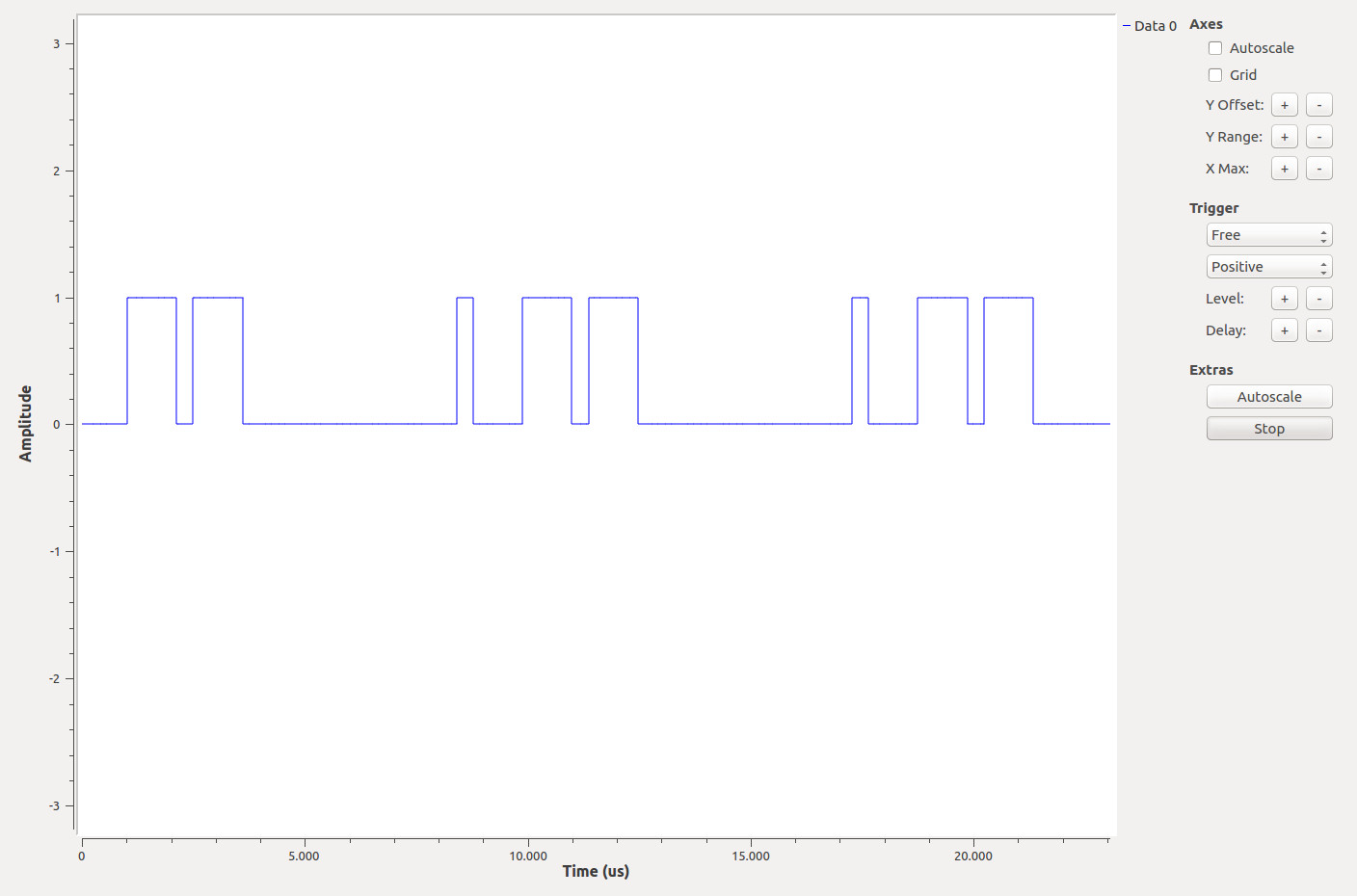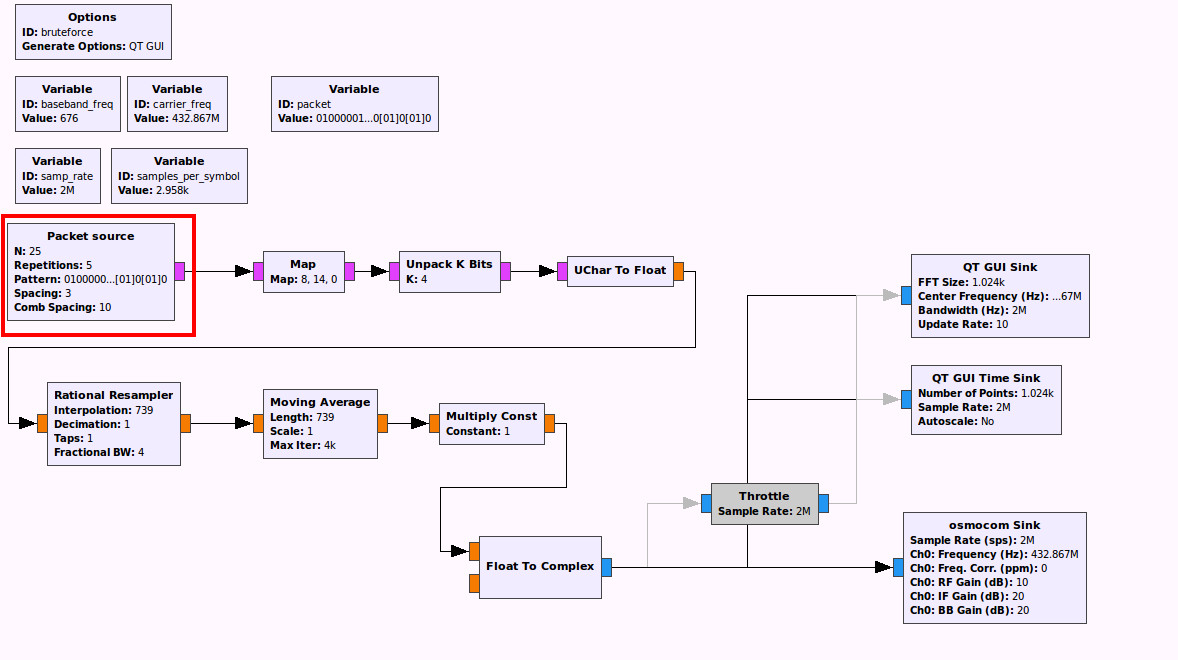Impersonating a remote using SDR and GNURadio
UPDATE - 2020-04-11
Since writing this article, GNURadio released a new version, which uses YAML to store the block configuration, instead of XML. Because of that, I tried to provide updated versions for all of the assets. However, if any of those don’t work, feel free to contact me and I’ll help you if I can.
Also, if you happened to fix any of those problems and want me to upload them here, just drop me a message (or a pull request) and will update this post :)
A couple of months ago I wrote a post talking about the capabilities of SDR, allowing us to sniff radio communications with very cheap hardware; and now I’m going to talk about the next step: using that same hardware to impersonate any device we want.
I’ve had everything ready for a long time but I couldn’t find time to write this post and record the videos with the demonstrations; so don’t think that this took me three months to prepare. In fact, it’s very simple. I chose a ridiculously easy target; but the same flow can be applied to any target you want and it should take you little time to start playing around.
Legal notice
Disclaimer:
I am not a lawyer, and everything I say on this section applies only to Spanish laws.
They may be similar in your country, or the may not. In any case, I recommend you to
take some time to consult someone who could tell you the legality of these experiments;
or at least take a look on your local regulations.
Before diving into the technical details, it’s important to know the legality of transmitting on certain frequency ranges. We didn’t have to worry about this on the previous part, listening to signals, as it’s legal to do it (at least where I’m from, Spain) except some special frequencies like military communications and the like.
Regarding transmission, this is all I could find about the laws here on Spain (all cited sources are on Spanish):
- According to the E.U. regulation (p. 11), “unspecific short range devices” (telemetry, remotes, alarms…) on the 433’92 MHz band can freely transmit with up to 10 mW of effective radiated power.
- On the latest frequencies assignations table (p. 12) from the Spanish government it seems to corroborate the 10 mW limit, stating also that anything that works on that band must accept interferences from other devices operating on that same frequencies.
If you are on the European Union, maybe this regulations apply to you, too; but it would be better if you’d check it, just in case…
Set up
As on the previous post, I’m going to work with the HackrfOne transceiver (the cheaper RTL won’t work here, as it doesn’t transmit). Also, the remote I’ll try to impersonate is the same one (an EM_MAN-001).
To test if the signal is correctly transmitted, I’ll plug two lights on a couple of receivers I had around the house.
That was the hardware. On the software side, this time I’ll use only GNURadio, with some custom blocks written in Python.
As a final note, the studied remote works with On-Off Keying - OOK, modulated in ASK, so the shown flowgraphs are designed to modulate in AM. This information was gathered on the previous post, along with the baseband frequency (needed to synthesize the signal).
Replaying the signal
This is the first and easiest method to try. It consists in capturing the desired signals and store them to simply replay them whenever we want.
The actual method to do it (with the flowgraphs) is more deeply explained on the previous post.
Although quite rudimentary, it’s a very simple first step that tells us a lot of things about the signal, whether it works or not:
- If the replayed signal generates a response from the receiver every time we transmit, we can conclude that the packets are always the same, without rolling codes, counters or any other variable.
- If, on the other hand, it only works sometimes (or at all), we can deduce that there’s some part of the packet that’s changing (like a counter or a rolling code). This tells us that the protocol is more complex and simply replaying a captured signal is not good enough. However, if it only works sometimes, we can stay a long time transmitting until the receiver accepts the message. This may not be very useful when activating a light; but it can be even dangerous if our car can be opened “ only sometimes “ (this may be caused by a rolling code with a short cycle).
Even when we fail to replay the signal, we can extract some information about the target.
If this method works for you (it should if your target is a remote like mine, or some toy), then congratulations :)
If it doesn’t, don’t give up, as there are other techniques you can try. Also, check that the signal is being transmitted correctly with another SDR. You should also check that all the parameters are correct (sampling rate, frequency…). If none of this works, you could change your target to an easier one.
Synthesizing the signal
The next step is to create the desired signal on the fly, directly from GNURadio, without any stored file with the captured signal, because this files tend to be very heavy and it’s very annoying to capture all the possible packets by hand.
So, how do we synthesize a signal?
The first thing is to create a squared wave with the signal we want. In this case, the coding used by the remote is On-Off Keying - OOK, and so the generated wave has to be like this:
To represent a '1': 3/4 of a period high, 1/4 low
To represent a '0': 1/4 of a period high, 3/4 low
Period: |0 |1 |2 |3 |
Bit: | '1' | '1' | '0' | '0' |
High -> _____ _____ __ __
| | | | | | | |
| | | | | | | |
Low -> ----+ +--+ +--+ +----- +------
Now, to generate this signal we can simply generate nibbles (4-bit numbers) and serialize
them to obtain the consecutive samples that are needed: let’s say we want to produce a
‘1’, represented by a long burst. If we stipulate that 4 bits are one period, then our
‘1’ would be 1110 (0xE), while a ‘0’ would be 1000 (0x8).
Knowing this, we’ll just generate an infinite series of 0’s and 1’s with the
Vector Source block and we’ll convert them to 0x8 or 0xE respectively with the Map
block. Finnally, the Unpack K bits block can be used to serialize those 4-bit numbers.
I also added some 2s that where mapped to 0x0 to create some blank space between packets.
The result is the following:
To ease my work I created a variable with the packet in a string and the vector source is generated using the following Python code:
[ int (x) for x in packet ] + [ 2 ] * spacing
Now that we have a squared signal, it’s time to upsample it to our desired sampling rate.
To do this, we can use the Rational Resampler block and set the interpolation to
samples_per_symbol / 4 (the ‘4’ comes from the fact that we’re generating 4 samples
for every bit), using the knowledge of the signal that we acquired when we
studied it. The samples_per_symbol variable is calculated using the baseband frequency
and the sampling rate as follows: int (samp_rate / baseband_freq). After the resampler,
I used a Moving Average filter (setting the length to samples_per_symbol / 4) to
create the pretty signal that can be seen on the following image:
Now it’s just a matter of modulating this squared wave to AM and send it. In fact… we don’t even need to modulate it (I guess the HackRF does it for us). This is the final flowgraph, that can be downloaded here (here is the updated version):
Bruteforcing
Once we can transmit data, the next step is to bring chaos to the world, sending every possible packet and turning everything on and off. I haven’t tested it yet, but I guess that this technique could also be used to defeat rolling codes by testing all combinations until the car opens…
To this end, the flowgraph is left untouched, except the generator of numbers, where
the Vector Source has been replace by a custom block whose code can be downloaded
here
(this version should
work with Python3). The new flowgraph can also be downloaded
over here
(and here is the
updated version).
This custom block takes a pattern (a regular expression) as an argument and, using either exrex or pure bruteforcing (whichever method is faster), generates all possible strings of 0’s and 1’s to be passed to the serializer.
The code of this block is quite simple, as it only uses a generator that yields every
packet (string of 0’s, 1’s and 2’s) and groups them into an array to be passed to the
next block.
As always, you are completely free (as in freedom) to modify these scripts and flowgraphs, and use them for whatever you want. The only thing I ask you is not to blame me when something goes wrong :D (although I’d appreciate some suggestions to improve them).
To show the bruteforcer in action, I used a couple of receivers to turn on and off some lights. In the following video I first show the remote being used, and then I start the bruteforcer, that goes through all the combinations (only on one channel), turning on and off the two lights:



